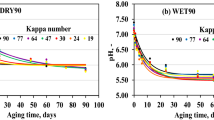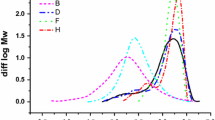Abstract
Accelerated aging tests are credible and useful to predict paper permanence only if such tests can be shown to correlate with natural aging. In the first part of this study, a kinetic model was developed based on the accelerated aging results. In this report, we have shown that this kinetic model can indeed predict the natural aging results of lignin-free sheets with a statistical confidence. This is the first quantitative comparison of accelerated aging with natural aging.
Similar content being viewed by others
References
Arney, J. S. and Jacobs, A. J. (1979) Accelerated aging of paper: the relative importance of atmospheric oxidation.Tappi J. 62(7), 98–91.
Arney, J. S. and Jacobs, A. J. (1982) Accelerated aging of paper: the influence of acidity on the relative contribution of oxygen-independent and oxygen-dependent processes.Tappi J. 65(3), 113–115.
Bansa, H. (1992) Accelerated aging tests in conservation research: some ideas for future method.Restaurator 13, 114–137.
Barrow, W. J. (1959–1967)Series of Reports from the Virginia State Library, Richmond, Virginia.
Bevington, P. R. (1969) Propagation of errors. inData Reduction and Error Analysis for the Physical Sciences, Chap. 4, New York: McGraw-Hill, p. 56.
Browning, B. L. and Wink, W. A. (1969) Studies on permanence and durability of paper: I. prediction of paper permanence.Tappi J. 51(4), 156–163.
de Grace, J. H. and Page, D. H. (1976) The extensional behaviour of commercial softwood bleached kraft pulps,Tappi J. 59(7), 98–101.
Draper, N. R. and Smith, H. (1966) Fitting a straight line by least squares. inApplied Regression Analysis, Chap. 1, New York: John Wiley & Sons.
Ekamstam, A. (1936) The behaviour of cellulose in mineral acid solutions: kinetic study of the decomposition of cellulose in acid solution.Ber. Deutschen Chem. Geseuschaft 69, 553.
Erhard, D., von Endt, D. and Hopwood, W. (1988) Paper degradation: a comparison of industrial and archival concerns. inPaper Preservation: Current Issues and Recent Developments, (P. Luner, ed.) Technology Park, Atlanta: TAPPI Press, pp. 63–68.
Graminski, E. L. (1976) The stress-strain behaviour of accelerated and naturally aged papers.Tappi J. 53(3), 406–410.
Graminski, E. L., Parks, E. J. and Toth, E. E. (1979) The effect of temperature and moisture on the accelerated aging of paper. inDurability of Macromolecular Materials (R. K. Eby, ed.)ACS Symp. Ser. 95, Chap. 24, pp. 342–355.
Gray, G. G. (1969) Accelerated aging study comparing kinetic rate vs. Tappi standard 453.Tappi J. 52(2), 325–334.
Hanson, F. S. (1939) The resistance of paper to natural aging.The Paper Industry and Paper World 20, 1157–1163.
Lewis, H. F. (1932) The relative stabilities of rag and purified sulfite pulps.Paper Trade J. 95(21), 29.
Luner, P. (1969) Paper permanence.Tappi J. 52(5), 796–805.
Luner, P. (1988) Evaluation of paper permanence.Wood Sci. Technol. 22, 81–97.
Major, W. D. (1958) The degradation of cellulose in oxygen and nitrogen at high temperature.Tappi J. 41(9), 530.
Millet, M. A., Wester, L. J. and Booth, J. J. (1967) Accelerated aging of cellulosic materials: design and application of a heating chamber.Tappi J. 50(11), 74A.
Parks, E. J. and Hebert, R. L. (1972) Accelerated aging of laboratory handsheets: reflectance, moisture regain, sonic modulus and differential thermal analysis.NBS Report 10-687, NTIS COM 75 10602.
Priest, D. J. (1994) Artificial aging of paper: correlation with natural aging,Proc. ASTM Workshop on the Effects of Aging on Printing and Writing Papers, Philadelphia, PA, pp. 50–60.
Rasch, R. H. and Scribner, B. W. (1933) Comparison of natural aging of paper with accelerated aging by heating.Natl. Bur. Stand. J. Res. 11(6), 727–732.
Richter, G. A. (1934) Accelerated aging tests for determining permanence of papers.Ind. Eng. Chem. 26(11), 1154.
Roberson, D. (1976) The evaluation of paper permanence and durability.Tappi J. 59(12), 63–69.
Shahani, C. J. (1994) Accelerated aging of paper: can it really foretell the permanence of paper?Proc. ASTM Workshop on the Effects of Aging on Printing and Writing Papers, Philadelphia, PA, pp. 120–139.
Shaw, M. B. and O'Leary, M. J. (1938) Effect of filling and sizing materials on stability of book papers.Natl. Bur. Stand. J. Res. 21(5), 671.
Strofer-Hua, E. (1990) Experimental measurement: interpreting extrapolation and prediction by accelerating aging.Restaurator 11, 254–266.
van Royen, A. H. (1957) Thermal degradation of wood and cellulose.Ind. Eng. Chem. 6(6), 223.
Wilson, W. K., Harvey, J. L., Mandel, J. M. and Worksman, T. (1955) Accelerating aging of records papers compared with natural aging.Tappi J. 38(9), 543–547.
Wilson, W. K. and Parks, E. J. (1980) Comparison of accelerated aging of book papers in 1937 with 36 years of natural aging.Restaurator 4, 1.
Zou, X., Gurnagul, N. and Uesaka, T. (1993) The role of lignin in the mechanical permanence of paper I. Effect of lignin content.J. Pulp Paper Sci. 19(6), J235–239.
Zou, X., Uesaka, T. and Gurnagul, N. (1996) Prediction of paper permanence by accelerated aging I. Kinetic analysis of the aging process.Cellulose 3, 243–267.
Author information
Authors and Affiliations
Rights and permissions
About this article
Cite this article
Zou, X., Uesaka, T. & Gurnagul, N. Prediction of paper permanence by accelerated aging II. Comparison of the predictions with natural aging results. Cellulose 3, 269–279 (1996). https://doi.org/10.1007/BF02228806
Issue Date:
DOI: https://doi.org/10.1007/BF02228806




